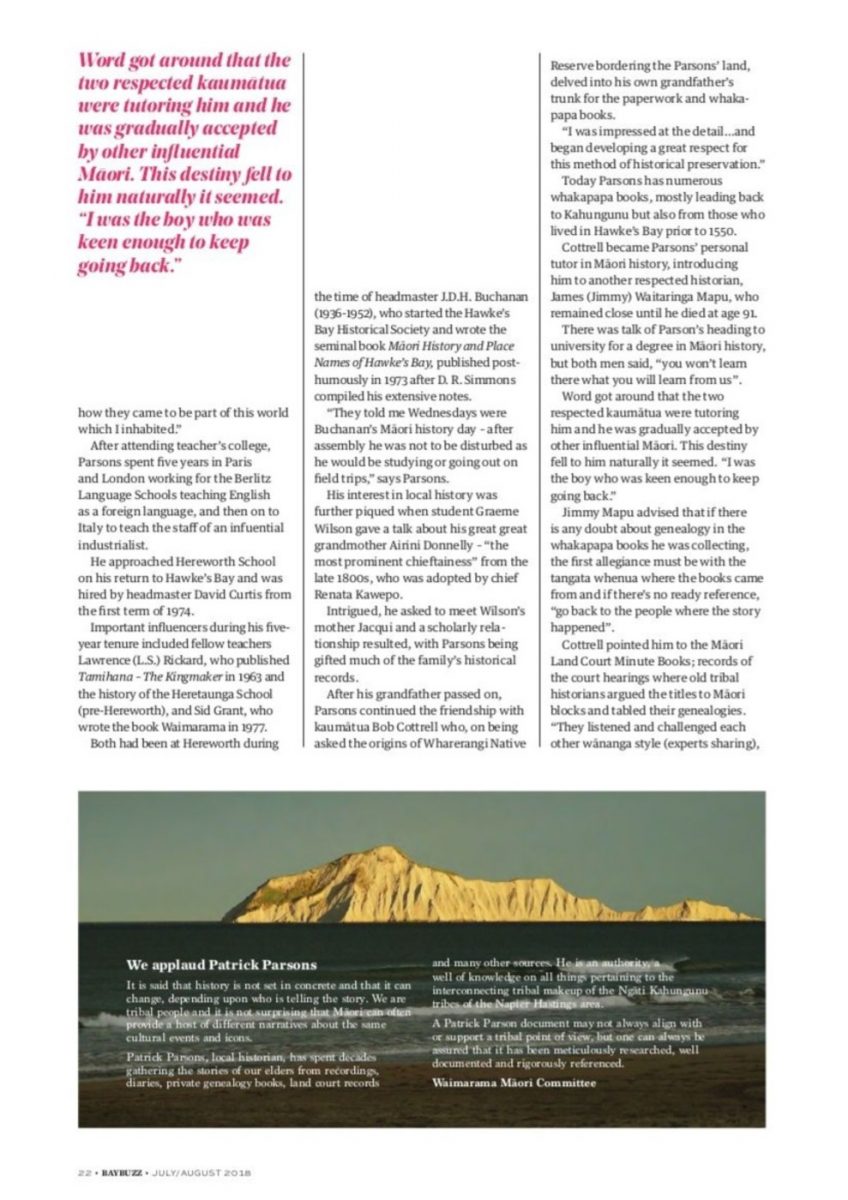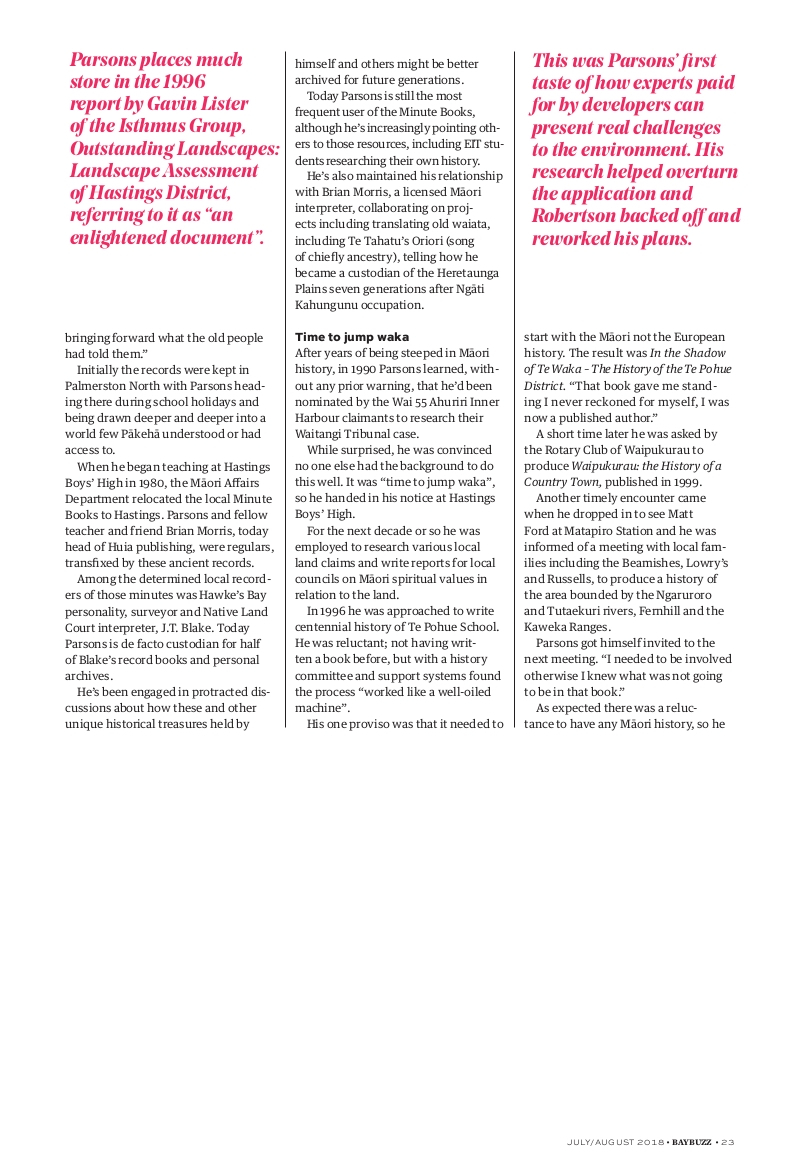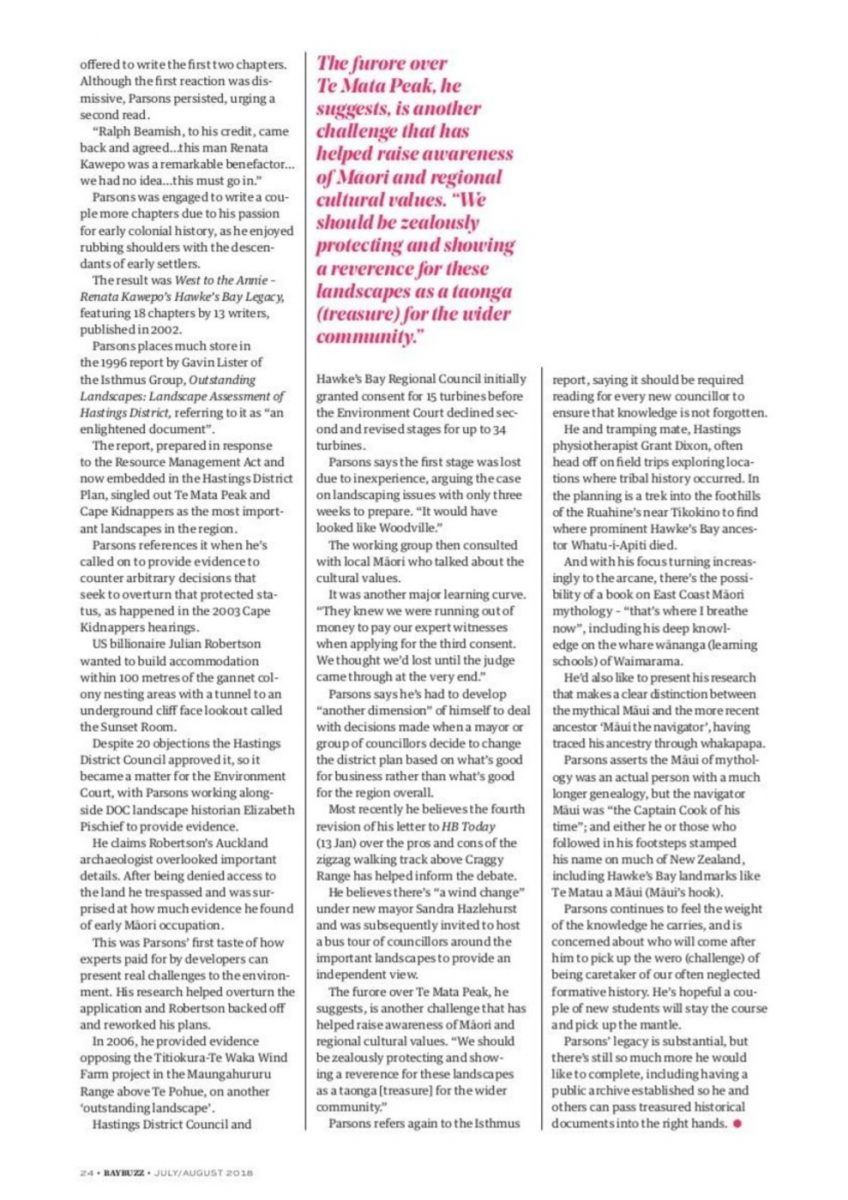offered to write the first two chapters. Although the first reaction was dismissive, Parsons persisted, urging a second read.
“Ralph Beamish, to his credit, came back and agreed… this man Renata Kawepo was a remarkable benefactor… we had no idea… this must go in.”
Parsons was engaged to write a couple more chapters due to his passion for early colonial history, as he enjoyed rubbing shoulders with the descendants of early settlers.
The result was West to the Annie – Renata Kawepo’s Hawke’s Bay Legacy, featuring 18 chapters by 13 writers, published in 2002.
Parsons places much store in the 1996 report by Gavin Lister of the Isthmus Group, Outstanding Landscapes: Landscape Assessment of Hastings District, referring to it as “an enlightened document”.
The report, prepared in response to the Resource Management Act and now embedded in the Hastings District Plan, singled out Te Mata Peak and Cape Kidnappers as the most important landscapes in the region.
Parsons references it when he’s called on to provide evidence to counter arbitrary decisions that seek to overturn that protected status, as happened in the 2003 Cape Kidnappers hearings.
US billionaire Julian Robertson wanted to build accommodation within 100 metres of the gannet colony nesting areas with a tunnel to an underground cliff face lookout called the Sunset Room.
Despite 20 objections the Hastings District Council approved it, so it became a matter for the Environment Court, with Parsons working alongside DOC landscape historian Elizabeth Pischief to provide evidence.
He claims Robertson’s Auckland archaeologist overlooked important details. After being denied access to the land he trespassed and was surprised at how much evidence he found of early Māori occupation.
This was Parsons’ first taste of how experts paid for by developers can present real challenges to the environment. His research helped overturn the application and Robertson backed off and reworked his plans.
In 2006, he provided evidence opposing the Titiokura-Te Waka Wind Farm project in the Maungahururu Range above Te Pohue, on another ‘outstanding landscape’.
Hastings District Council and Hawke’s Bay Regional Council initially granted consent for 15 turbines before the Environment Court declined second and revised stages for up to 34 turbines.
Parsons says the first stage was lost due to inexperience, arguing the case on landscaping issues with only three weeks to prepare. “It would have looked like Woodville.”
The working group then consulted with local Māori who talked about the cultural values.
It was another major learning curve. “They knew we were running out of money to pay our expert witnesses when applying for the third consent. We thought we’d lost until the judge came through at the very end.”
Parsons says he’s had to develop “another dimension” of himself to deal with decisions made when a mayor or group of councillors decide to change the district plan based on what’s good for business rather than what’s good for the region overall.
Most recently he believes the fourth revision of his letter to HB Today (13 Jan) over the pros and cons of the zigzag walking track above Craggy Range has helped inform the debate.
He believes there’s “a wind change” under new mayor Sandra Hazlehurst and was subsequently invited to host a bus tour of councillors around the important landscapes to provide an independent view.
The furore over Te Mata Peak, he suggests, is another challenge that has helped raise awareness of Māori and regional cultural values. “We should be zealously protecting and showing a reverence for these landscapes as a taonga [treasure] for the wider community.”
Parsons refers again to the Isthmus report, saying it should be required reading for every new councillor to ensure that knowledge is not forgotten.
He and tramping mate, Hastings physiotherapist Grant Dixon, often head off on field trips exploring locations where tribal history occurred. In the planning is a trek into the foothills of the Ruahine’s near Tikokino to find where prominent Hawke’s Bay ancestor Whatu-i-Apiti died.
And with his focus turning increasingly to the arcane, there’s the possibility of a book on East Coast Māori mythology – “that’s where I breathe now”, including his deep knowledge on the whare wānanga (learning schools) of Waimarama.
He’d also like to present his research that makes a clear distinction between the mythical Māui and the more recent ancestor ‘Māui the navigator’, having traced his ancestry through whakapapa.
Parsons asserts the Māui of mythology was an actual person with a much longer genealogy, but the navigator Māui was “the Captain Cook of his time”; and either he or those who followed in his footsteps stamped his name on much of New Zealand, including Hawke’s Bay landmarks like Te Matau a Māui (Māui’s hook).
Parsons continues to feel the weight of the knowledge he carries, and is concerned about who will come after him to pick up the wero (challenge) of being caretaker of our often neglected formative history. He’s hopeful a couple of new students will stay the course and pick up the mantle.
Parsons’ legacy is substantial, but there’s still so much more he would like to complete, including having a public archive established so he and others can pass treasured historical documents into the right hands.
24 • BAYBUZZ • JULY/AUGUST 2018















Do you know something about this record?
Please note we cannot verify the accuracy of any information posted by the community.